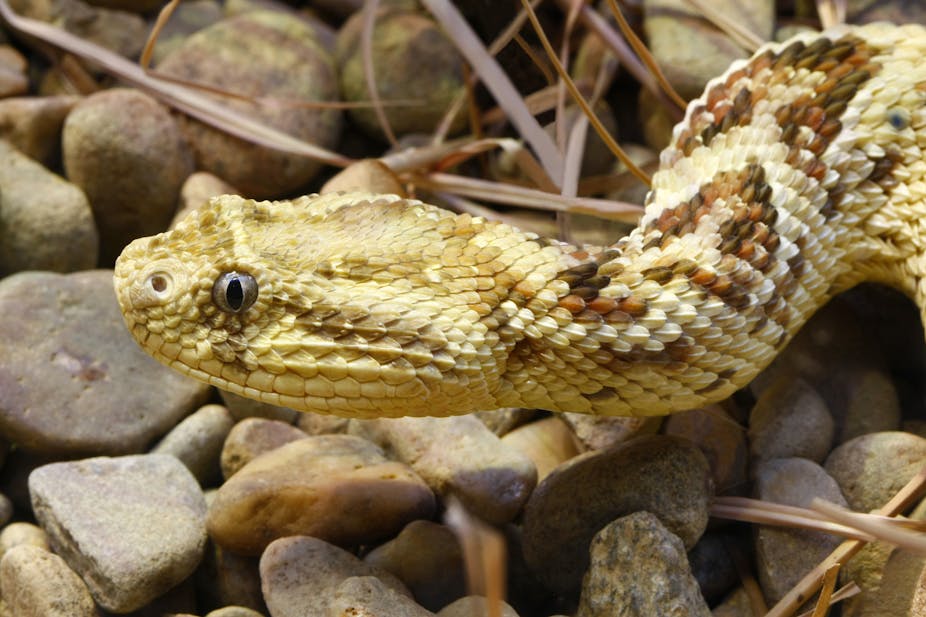The puff adder (Bitis arietans) is one of the most widespread and venomous snakes in Africa. It is responsible for more deaths on the continent than any other snake. It is an extreme ambush forager, often lying motionless for days at a time, waiting for prey to pass within striking range.
Our extensive radio-telemetry of puff adders has revealed that, unlike other snakes, they spend most of their lives above ground, seldom seeking refuge beneath rocks or down burrows. During these long bouts in ambush, an easily detectable puff adder would be a sitting duck to any predator. And its ability to escape attack by fleeing is limited due to the fact that it has a squat body. Instead, puff adders rely on their ability to hide in plain sight using their astonishingly good camouflage.
The puff adder’s risk of being eaten is remarkably high. It has as many as 42 documented species of predators, and data collected during our extensive studies on this species show that in some years, annualised mortality rates can approach 50% of the adult population. In a system like this, the selective pressures acting on a species are great, and may result in an evolutionary arms race between predator and prey.
The puff adder’s impressive visual camouflage is testament to this. Its cryptic colouration and patterning is so effective that during our studies, finding individuals that had been radio-tracked down to a square metre often took an extra 15 minutes to actually find.
The puff adder has an additional survival mechanism that, until now, little has been known about. This is that unlike the other five snake species we tested, it doesn’t carry a scent. This makes it undetectable to even the most-keenly nosed predators.
Why smell matters
Not all of the puff adder’s predators rely on vision to locate their prey. As many as 15, including dogs, meerkats and mongooses, rely on their keen sense of smell to find their food. This hunting style simply bypasses the effectiveness of the puff adder’s visual camouflage. Yet, from our observations in the field, it was clear that in response to an approach by predators, resting and ambushing puff adders choose to remain motionless.

In fact, they are so committed to this that we have observed dogs and mongooses walking directly over puff adders with no response from the snake. And at the same time, neither the dogs nor the mongooses demonstrate any awareness of the snakes.
These observations led us to a very intriguing question. Are puff adders evading their scent-orientated predators by hiding or reducing their scent?
To answer this question, our research team implemented a novel approach. We enlisted a team of scent-matching dogs and meerkats. These puff adder predators were trained to test whether they could locate puff adders using smell alone.
The use of detection dogs as research tools is growing in popularity within the field of ecology. They are now routinely used to locate rare, elusive or invasive species. Dogs are trained onto a specific target scent, which they must reliably and repeatedly indicate to gain reward.
But in this case the research team needed their dogs and meerkats to do much more. You can’t train a dog or meerkat onto a species’ target scent if the species is scentless. So, the dogs and meerkats were required to match pairs of new scents to each other among a line-up of scent options. This is much more challenging and it took the dogs and meerkats months to learn this skill. But once they had, the researchers were able to test how smelly some snake species were to these sniffer extraordinaires.

It turned out that of the six snake species tested, one stood out as being undetectable. In 100 scent-matching trials, puff adders stumped both the dog and meerkat teams every time. They failed to correctly match the puff adder scent pairs to each other at rates greater than chance.
The results from the other snake species were very different. Both dogs and meerkats were able match pairs of these smelly snake scents around 90% of the time. This makes the puff adder the first terrestrial vertebrate species for which chemical crypsis – the art of being scentless – has been demonstrated.
Although these findings are a world-first, we believe that this phenomenon is likely to be common in the animal world. Ambushing animals that experience high mortality rates as a result of predation, and animals that remain in an exposed locality, such as incubating, ground-nesting birds and newly born fawns, are likely to derive great benefit from being scentless or being able to mask their odour in some way.
Chemical crypsis has probably not been shown before simply due to research focus being biased towards our own primary sense – vision. We hope that the findings act as a springboard to many avenues of research on chemical crypsis in other systems. But we are now focused on figuring out how puff adders are doing it.
This article is based on a more comprehensive academic paper, published in the Proceedings of the Royal Society B.

